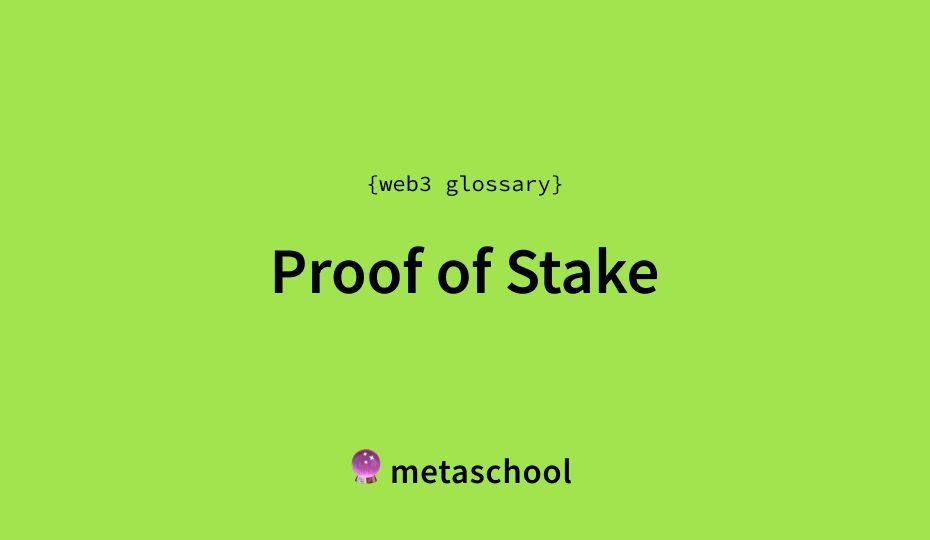Table of Contents
What is Proof of Stake?
Proof of stake (PoS) is a type of algorithm used by some cryptocurrencies to achieve distributed consensus. It is an alternative to the more widely-used proof of work (PoW) algorithm, which is used by cryptocurrencies such as Bitcoin.
In PoW-based systems, the creator of a new block (i.e., a miner) is chosen based on their ability to solve a computationally difficult problem. This involves performing a large number of calculations, which require a significant amount of energy to complete. The miner who is able to solve the problem first is rewarded with a certain number of units of the cryptocurrency, as well as any transaction fees that are included in the block.
In contrast, in PoS-based systems, the creator of a new block is chosen in a deterministic way, depending on the amount of cryptocurrency they hold, or “stake” in the system. This means that the more cryptocurrency a user holds, the more likely they are to be chosen to create a new block. When a user is selected to create a new block, they are also rewarded with a certain number of units of the cryptocurrency.
PoS: Advantages ✅
One of the main advantages of PoS over PoW is that it is much more energy-efficient. Because miners do not need to perform computations in order to create new blocks, PoS-based systems do not require as much energy to operate. This makes them more sustainable and less damaging to the environment than PoW-based systems.
Another advantage of PoS is that it is more secure than PoW. In PoW-based systems, an attacker who controls a large amount of computing power can potentially launch a 51% attack, in which they are able to create a longer chain of blocks than the legitimate blockchain and double-spend their cryptocurrency.
In PoS-based systems, however, an attacker would need to control a large amount of the cryptocurrency in order to launch a successful attack, which is much more difficult and expensive to do.
PoS: Challenges ❌
One of the challenges with PoS is that it can lead to centralization, as users with large amounts of cryptocurrency are more likely to be selected to create new blocks. This can make the network more vulnerable to attacks, as a small number of users control the majority of the cryptocurrency.
To address this issue, some PoS-based systems use a variant called “delegated proof of stake” (DPoS), in which users can delegate their stake to other users who are then responsible for creating new blocks. This can help to distribute the power to create new blocks more evenly among users.
In conclusion, proof of stake is a type of algorithm used by some cryptocurrencies to achieve distributed consensus. It offers several advantages over proof of work, including increased energy efficiency and improved security.
However, it can also lead to centralization, which can make the network more vulnerable to attacks. Despite these challenges, PoS is a promising approach to distributed consensus, and is likely to continue to be used by a growing number of cryptocurrencies in the future.
The shift from Proof of Work to Proof of Stake
Proof of Stake was created as an alternative to Proof of Work. While in POW, miners have to solve cryptographic puzzles to earn crypto; in POS the validators have to stake and hold tokens for earning crypto and to have the privilege to add a new block to a chain.
The Ethereum Blockchain was shifted to the Proof of Stake consensus mechanism in September 2022 because Ethereum developers understood from the beginning that the old consensus mechanism, Proof of Work, is limited and has scalability problems that need to be overcome.
Ethereum’s developers had been thinking of the shift ever since 2015 but it was delayed due to complexities and eventually done in 2022. It was necessary because Ethereum is not limited to cryptocurrency transactions but also supports stablecoins, smart contracts, NFT minting, and DeFi transactions.
This shift of consensus mechanism is known as The Merge in which the Beacon Chain was merged with the Ethereum Blockchain. This chain helps the Ethereum increase the transaction speeds as well as create and validate new blocks in the blockchain.
Unlike PoW, in PoS the network decides a winner based on the amount of crypto they have invested.
All other participating validators receive rewards in native cryptocurrency distributed in proportion to each validator’s investment or stake.
One of the highlights of POS is that it will reduce electricity consumption and people no more have to spend money on different equipment which was previously needed for PoW and mining.
The merge will reduce worldwide electricity consumption by 0.2%
Vitalik Buterin, Ethereum co-founder
This event was so big and historical in the blockchain ecosystem that Vitalik Buterin celebrated it by saying,
[It] has obviously been a dream for the Ethereum ecosystem since pretty much the beginning. We started the proof-of-stake research with that blog post on Slasher back in January 2014
The 51% attack, unlike on POW, has been made virtually impossible on the POS. This is because it would cost thousands of dollars for 1 hour and even an honest validator can vote against it and burn the offenders staked ETH.
